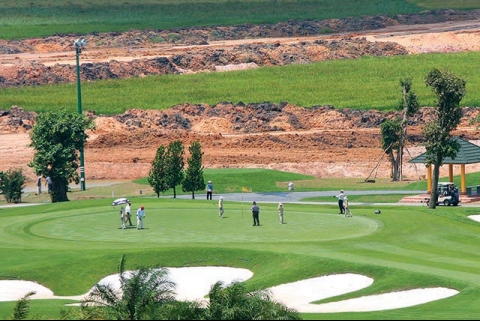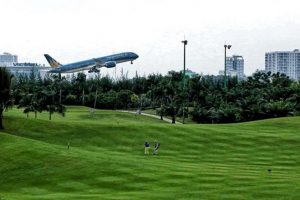With a coastline of 3,260 km, including world-famous beaches and bays and with a tropical climate, Vietnam is considered an ideal place for golf courses.
In 1922, French architect Ernest Hébrard first created the golf course master plan, for the central highlands city of Da Lat, and then ten years later, in 1933, the first nine-hole golf course in the Indochina began welcoming golfers, officially putting Vietnam on the global golf course map.
After a period of stagnation due to the country’s wars of liberation, 60 years later, in 1993, the King Island Golf Course near Hanoi was opened, marking the return of golf to the country and its process of economic renovation.
With planning from the Prime Minister for there to be 90 golf courses to 2025, many golf projects have sprung up and are springing up around the country.
Appearing everywhere
Most recently, the FLC Group started its FLC Samson Beach Golf and Resort project, which is expected to open after ten months of construction. The FLC Samson Golf Links will be the highlight of the golf course – resort – hotel complex, on an area of 450 ha and with total investment of nearly VN5.5 trillion ($253 million). The Group will also build a cultural and tourism complex on 300 ha with total investment of VND2.2 trillion ($101.2 million), which will have a luxury resort, townhouses, hotels and entertainment areas.
Earlier, based on a proposal from the Ministry of Planning and Investment, the Prime Minister agreed to a 36-hole golf course project on Vu Yen Island, invested by Vingroup, being added to the golf planning to 2020. The course has an area of 1.6 million sq m and is part of the Vu Yen Island Ecotourism Urban Area project in Hai Phong city, which will include ecological villas, amusement parks, and an ecological park on an area of 872 ha.
In May, the Hong Hac Dai Lai JSC, the owner of the Flamingo Dai Lai Resort in northern Vinh Phuc province, officially opened a new nine-hole golf course and an 18-hole miniature putting course. The latter is the largest in the north. Considered a new form of recreation for villa owners and visitors, Ms. Le Thi Van Anh, General Director of Hong Hac Dai Lai said the Resort has become a popular tourist destination in Vietnam and the company continually upgrades and expands its facilities to meet the ever-growing demands of owners and visitors. “The golf course and putting course are part of our plans to develop Vietnam’s largest recreation services at Flamingo Dai Lai Resort in the future,” she said.
In the last three years, five-star golf course – resorts have appeared along Vietnam’s central coast, such as Lang Co Beach Resort of the Banyan Tree Group and Norman Estates in Thua Thien Hue province. These efforts were recognized when Vietnam was voted among the leading the golf tourism destinations in 2008 and four years later among the best tourist destinations in Southeast Asia by the International Association of Golf Tour Operators.
Clearly, golf course – resorts are becoming a new trend of investment in Vietnam. Experts believe that the combination not only diversifies services to meet the needs of tourists but also adds value to the tourism industry. Mr. John Blanco, CEO of The Nam Hai Resort, said that 30 per cent of guests staying at the resort play golf. Meanwhile, at Da Nang Golf Club, the number of players specifically in town for golf is increasing, especially foreigners, Mr. Blanco was quoted as saying.
Golf courses can bring many benefits to real estate investors as they are perfect for resort chains with hotels, villas and entertainment, and they bolster the reputation of any resort. But a golf course by itself brings little profit to investors. Ms. Nguyen Thi Nga, Chairwoman of the BRG Group, one of the largest golf investors in Vietnam and owner of the Legend Hill Golf Resort, told the Wall Street Journal that the $100 million course would itself not earn a profit but may increase the number of visitors coming to Legend Hill.
Profit is mainly based on real estate. Revenues from golf courses and related services are generally only enough to cover operating costs, a representative from one golf course said. “Golf courses that are too far away from urban areas and not in a beautiful location will give investors a headache,” he said. “Golf courses should therefore only be associated with a resort.”
Inadequacies & shortcomings
Although investments in golf courses have increased significantly recently, especially those combined with resorts, such investment is still low compared to other countries around the world. Vietnam currently has 32 golf courses with 90 planned to 2025, while regional countries have hundreds of courses, such as Indonesia, with 152, Malaysia 230, and Thailand 253. Golf in Vietnam is still at a low level compared to the country’s neighbors.
Earning a profit on a golf course is certainly not easy. Recently, the owner of the Phan Thiet Golf Course proposed the provincial government allow it to convert the land it had for the course into an urban area, due to poor business results. One expert said that in order to regain the capital invested in an 18-hole golf course like Phan Thiet, it must attract at least 30,000 golfers each year. If investors want to earn a profit of 10 per cent they must attract at least 33,000 golfers each year. Golf courses can also be harmful on the surrounding environment due to the amount of water and chemicals used to nourish the grass. According to analysis by Golf Digest, a well-known golf magazine in the US, an 18-hole course needs 150,000 cubic meters of water each month, which is equal to the water use of 20,000 households. Issues relating to land acquisition for the golf course also make life difficult for investors.
Despite acknowledging that golf courses can have a negative impact on the surrounding environment and residents if strict management is not applied, Mr. Nguyen Van Hao, General Secretary of the Vietnam Golf Association, believes that with the trend towards global integration the development of golf course is inevitable. It attracts foreign investors, promotes tourism, and creates jobs, he said. There are 32 golf courses around the country, employing nearly 10,000 workers. Golf courses also contribute more than VND500 billion ($23 million) to the State budget each year, golf course – resorts included. In Hoa Hai ward in Da Nang city, he said, annual per capita income increased from $400 to $1,200 after a golf course – resort was built.
There is still a commonly held view, however, that golf courses only serve the wealthy, who represent a small section of society, and the government should therefore issue stricter directives on the planning and management of courses to serve both the development needs of the country and to ensure benefits for those living in surrounding areas.
VET
The article "In the swing" was originally published on http://english.vietnamnet.vn/fms/business/138817/in-the-swing.html





